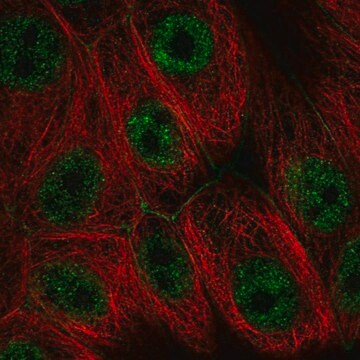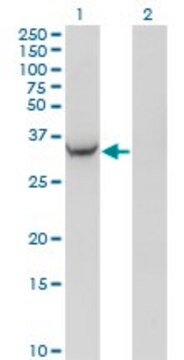HTS024RTA
Ready-to-Assay CRF2 Corticotropin Releasing Factor Receptor Frozen Cells
Sélectionner une taille de conditionnement
1 070,00 $
Sélectionner une taille de conditionnement
About This Item
1 070,00 $
Produits recommandés
Description
Cell line type: GPCR Cell Lines
GPCR Class B
protein target CRF2
Niveau de qualité
Technique(s)
calcium flux assay: suitable
Méthode de détection
fluorometric
Description générale
The corticotropin-releasing factor receptors, CRF1 and CRF2, are Gs-coupled GPCRs expressed in the brain, blood vessels and intestine that bind to several neuropeptides, including corticotropin-releasing factor (CRF) and urocortin, and the amphibian peptide sauvagine (Lovenberg et al., 1995; Bale and Vale, 2004). In addition, two peptides, urocortin II (Ucn II) and urocortin III (Ucn III), bind selectively and with high affinity to CRF2 (Lewis et al., 2001). The CRF peptides and their receptors play important roles in stress mediated by the hypothalamic-pituitary-adrenal axis in animal models, and possibly in depression and anxiety in humans, although the contributions of CRF1 and CRF2 appear to be distinct (Bale and Vale, 2004; Risbrough et al., 2004) In addition, CRF1 and CRF2 differentially alter feeding behavior, gastric motility and vascular tone (Zorrilla et al., 2004; Martinez et al., 2004; Wiley and Davenport, 2004). Millipore′s cloned human CRF2-expressing cell line is made in the Chem-1 host, which supports high levels of recombinant CRF2 expression on the cell surface and contains high levels of the promiscuous G protein Gα15 to couple the receptor to the calcium signaling pathway. Thus, the cell line is an ideal tool for screening for agonists, antagonists and modulators at CRF2.
Composants
Clause de non-responsabilité
Code de la classe de stockage
10 - Combustible liquids
Classe de danger pour l'eau (WGK)
WGK 1
Point d'éclair (°F)
Not applicable
Point d'éclair (°C)
Not applicable
Certificats d'analyse (COA)
Recherchez un Certificats d'analyse (COA) en saisissant le numéro de lot du produit. Les numéros de lot figurent sur l'étiquette du produit après les mots "Lot" ou "Batch".
Déjà en possession de ce produit ?
Retrouvez la documentation relative aux produits que vous avez récemment achetés dans la Bibliothèque de documents.
Notre équipe de scientifiques dispose d'une expérience dans tous les secteurs de la recherche, notamment en sciences de la vie, science des matériaux, synthèse chimique, chromatographie, analyse et dans de nombreux autres domaines..
Contacter notre Service technique





